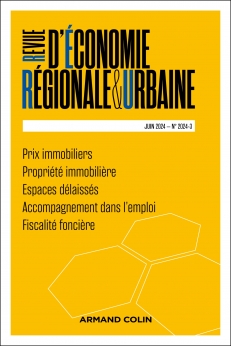
REVUE D'ÉCONOMIE RÉGIONALE ET URBAINE (3/2024)
Pour acheter ce numéro, contactez-nous
Recevez les numéros de l'année en cours et accédez à l'intégralité des articles en ligne.
Si, de nos jours, les espaces délaissés urbains sont perçus négativement par l’imaginaire collectif en France, il n’en a pas toujours été ainsi. Nous proposons, au croisement de l’économie et de l’aménagement urbain, une relecture du concept des trois âges de l’urbanisme d’Albert Lévy (1998) sur les mutations de la ville française. L’objectif de l’article est de montrer, qu’à partir des années 1990-2000, l’évolution des perceptions et la réappropriation des espaces délaissés urbains par des réseaux d’acteurs informels reposent sur de nouvelles valeurs, marqueurs d’un nouveau modèle socioéconomique émergeant en rupture avec celui du modèle productiviste en crise des années 1970. Nous montrons que ces valeurs préfigurent un nouveau modèle urbain où les espaces délaissés retrouvent un statut comme jachères urbaines dans les stratégies des villes, notion que nous conceptualisons comme potentiels d’expérimentation et d’adaptation d’un modèle urbain résilient.
Nowadays in France, urban leftovers (wastelands, voids, abandoned or neglected spaces) are perceived negatively by the collective imagination, however this has not always been the case. We propose, via a combination of economics and urban planning, a reinterpretation of Albert Lévy’s concept of the three ages of urbanism (1998) on the mutations of the French city throughout History. The aim of this paper is to show that, as of the 1990/2000s, the evolution of perceptions and the re-appropriation of urban leftovers through informal networks of actors rely on new values. This set of values characterise a new emerging social and economic model breaking with the crisis of the production-driven model. We show that these values suggest a new urban model in which urban leftover spaces regain a certain status as urban fallows in town planning strategies, a notion which we conceptualize as a potential for experimentation and adaptation for a resilient urban model. While being markers of the history of cities, signs of past crises and ruptures, urban leftovers are rarely highlighted in the chronology of urban practices and forms. Therein lies the originality of this paper. Furthermore, although Albert Lévy’s model of the three ages of urbanism (1998) is originally based on a reading of the mutations of the French city, its scope is wider as it features a Western understanding of cities which has been shaped over the years by European models as well as the North American model. These characteristics make it an exploitable model for other cities that are experimenting with their urban leftover spaces.